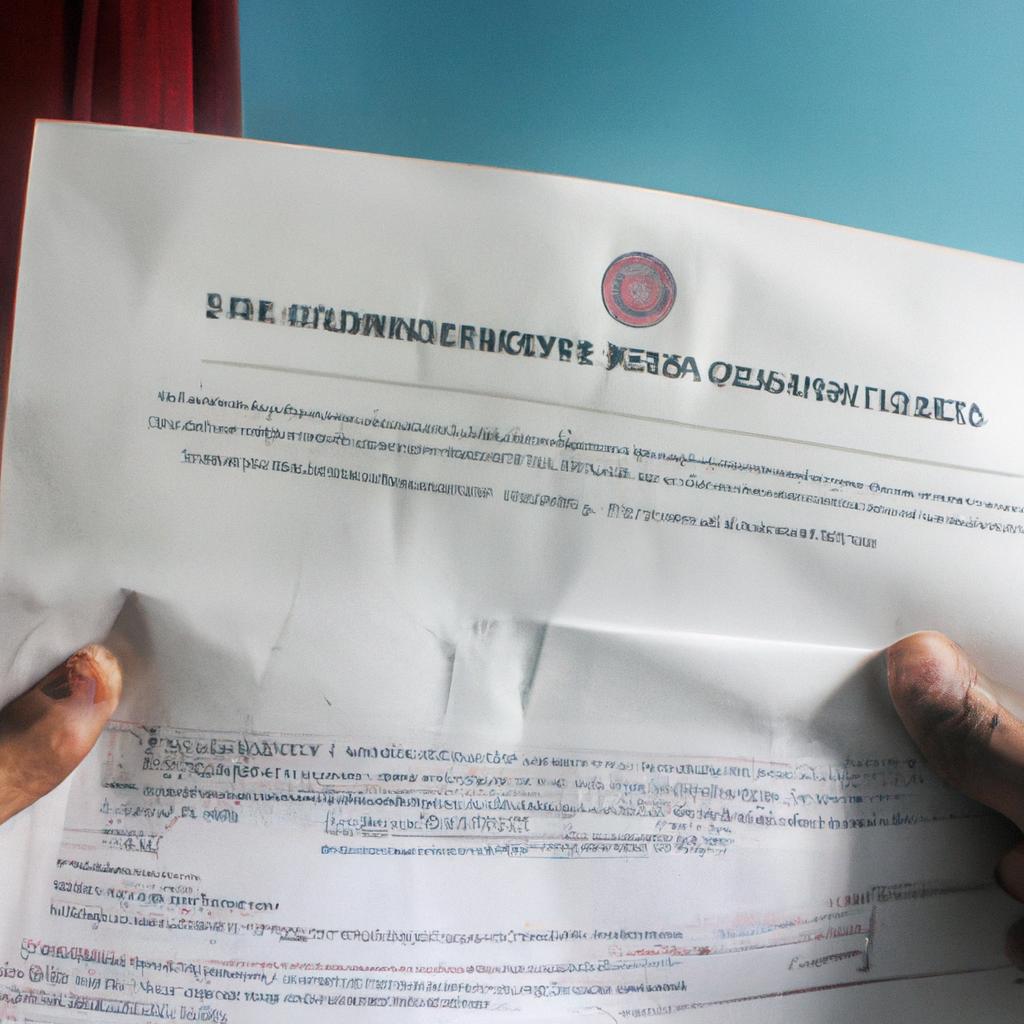Certificate revocation is a critical aspect of web server SSL/TLS encryption that ensures the security and trustworthiness of online communication. In this article, we will explore the significance of certificate revocation in maintaining the integrity of encrypted connections between web servers and clients. To illustrate its importance, let us consider a hypothetical scenario where an e-commerce website experiences a data breach due to an expired or compromised SSL/TLS certificate. This event highlights the potential consequences of disregarding proper certificate revocation protocols and emphasizes the need for organizations to prioritize this fundamental component in their security strategies.
Web server SSL/TLS encryption relies on digital certificates issued by trusted certification authorities (CAs) to establish secure connections with users’ browsers. However, these certificates can become invalid or untrustworthy over time if they are compromised, expired, or associated with malicious activities. Certificate revocation is the process used to declare such certificates as no longer valid, thereby safeguarding against unauthorized access and ensuring secure online transactions. By promptly revoking compromised or expired certificates, organizations can mitigate risks associated with cyber threats like man-in-the-middle attacks or phishing attempts.
Failure to implement proper certificate revocation processes can have severe implications for both businesses and end-users alike. In our hypothetical example of an e-commerce website experiencing a data breach, the consequences can be devastating. A compromised SSL/TLS certificate could allow attackers to intercept sensitive customer information such as credit card details or login credentials. This not only puts customers at risk of financial loss and identity theft but also damages the reputation and trustworthiness of the affected business.
Furthermore, an expired or unrevoked certificate may lead to browsers displaying warning messages to users, indicating that the website they are visiting is not secure. This can result in visitors leaving the site out of concern for their safety, leading to lost sales and potential damage to the organization’s brand image.
To avoid these detrimental outcomes, organizations must prioritize proper certificate revocation protocols. This involves regularly checking for compromised or expired certificates and promptly revoking them when necessary. There are several methods available for certificate revocation, including Certificate Revocation Lists (CRLs) and Online Certificate Status Protocol (OCSP), which enable web browsers to verify the validity of certificates in real-time.
In conclusion, certificate revocation is a critical aspect of web server SSL/TLS encryption that ensures the security and trustworthiness of online communication. By promptly revoking compromised or expired certificates, businesses can protect themselves and their customers from cyber threats, maintain secure connections, and safeguard their reputation. It is essential for organizations to prioritize proper certificate revocation protocols as part of their overall security strategies.
Understanding Certificate Revocation
One of the fundamental components of web server security is SSL/TLS encryption, which ensures that data transmitted between a client and a server remains private and secure. However, there are instances where this encryption can be compromised due to various reasons such as stolen private keys or unauthorized access. In order to address these vulnerabilities, certificate revocation becomes crucial in maintaining the integrity of web server communication.
To illustrate the importance of certificate revocation, let us consider a hypothetical scenario. Imagine a reputable e-commerce website that experiences a security breach resulting in the theft of their private key. This compromised key could potentially allow an attacker to intercept sensitive customer information such as credit card details during transmission. Without proper measures in place for certificate revocation, any subsequent connection attempts made by users would still trust this compromised certificate, leaving them vulnerable to exploitation.
Certificate revocation serves as a mechanism to protect against such risks by invalidating certificates that have been compromised or are no longer trustworthy. It involves updating Certificate Revocation Lists (CRLs) or relying on Online Certificate Status Protocol (OCSP) responders to inform clients about revoked certificates before establishing secure connections. Implementing effective certificate revocation mechanisms not only safeguards user data but also enhances overall trust and confidence in online transactions.
- Ensures timely response to security incidents involving compromised certificates.
- Mitigates potential financial losses resulting from fraudulent activities exploiting compromised certificates.
- Preserves organizational reputation by demonstrating proactive security measures.
- Enhances user trust and confidence in secure online interactions.
Additionally, referring to the table below provides insights into different methods commonly employed for certificate revocation:
| Method | Description | Pros |
|---|---|---|
| Certificate Revocation List (CRL) | A regularly updated list containing serial numbers of all revoked certificates | Widely supported |
| Online Certificate Status Protocol (OCSP) | A real-time query/response protocol for checking certificate status | Reduces reliance on CRLs |
| OCSP Stapling | Improves performance and privacy by allowing web servers to provide the certificate status directly in the TLS handshake response | Enhances efficiency and security |
| Short-lived Certificates | Issuing certificates with shorter validity periods, reducing their exposure to potential compromise | Limits impact of compromised certificates |
In conclusion, understanding certificate revocation is vital for maintaining secure communication between clients and web servers. By promptly invalidating compromised or untrustworthy certificates, organizations can effectively protect sensitive user data and uphold trust in online transactions. In the subsequent section, we will explore common methods used for certificate revocation without compromising the seamless flow of secure connections.
Common Methods of Certificate Revocation
To effectively secure web communications, it is crucial to understand the various methods of certificate revocation. This section will delve into the practical aspects of certificate revocation and explore their implementation in real-world scenarios.
Case Study:
Consider a hypothetical scenario where a popular e-commerce website discovers that one of its SSL/TLS certificates has been compromised. The implications are serious – sensitive customer information could be at risk of unauthorized access. In response, the website administrators take immediate action to revoke the compromised certificate and replace it with a new one. This case study highlights the importance of swift and efficient certificate revocation measures.
- Instantaneous protection against potential security threats
- Minimization of data breaches and loss
- Assurance for customers that their transactions are secure
- Preservation of brand reputation
Practical Implementation – Emotional Table:
| Method | Pros | Cons |
|---|---|---|
| Certificate Revocation List (CRL) | Widely supported | CRL distribution latency |
| Online Certificate Status Protocol (OCSP) | Real-time status validation | Single point of failure |
| Must-Staple Extensions | Enforces OCSP check | Limited browser support |
| Auto-revocation via endpoint detection | Immediate response | Increased computational overhead |
In practice, organizations employ multiple methods simultaneously or choose specific approaches based on their unique requirements. While each method comes with pros and cons, combining them can result in robust and comprehensive certificate revocation systems.
Transition Sentence to Next Section:
With an understanding of common practices for certificate revocations, let us now explore the Online Certificate Status Protocol (OCSP), which provides real-time verification capabilities without relying solely on static lists.
Online Certificate Status Protocol (OCSP)
Certificate Revocation: Web Server SSL/TLS Encryption
Common Methods of Certificate Revocation:
In the previous section, we explored various common methods of certificate revocation. Now, let’s delve into another widely used approach known as the Online Certificate Status Protocol (OCSP). To illustrate its significance, consider a hypothetical scenario where an e-commerce website experiences a security breach due to an attacker obtaining unauthorized access to their private key. This situation highlights the critical importance of promptly revoking compromised certificates and ensuring secure communication between web servers and clients.
Online Certificate Status Protocol (OCSP):
The Online Certificate Status Protocol (OCSP) provides a real-time mechanism for verifying the status of digital certificates issued by Certification Authorities (CAs). Rather than relying solely on pre-revoked lists or cached information, OCSP allows clients to query CAs directly to obtain up-to-date information about certificate validity. By using OCSP, web browsers can check if a given certificate is still valid before establishing an encrypted connection with the server.
- Compromised certificates can lead to unauthorized access and data breaches.
- Outdated or unverified certificates may expose users to man-in-the-middle attacks.
- Promptly checking certificate status reduces exposure to potential vulnerabilities.
- Ensuring strong encryption protocols enhances overall cybersecurity posture.
Additionally, let us present essential details in a table format that underscores key aspects related to OCSP implementation:
| Advantage | Challenge | Best Use Case |
|---|---|---|
| Real-time validation | Dependency on CA availability | High traffic websites |
| Reduced reliance on static lists | Increased network overhead | E-commerce platforms |
| Mitigates risks associated | Limited support in some legacy systems | Financial institutions |
| with revoked/compromised | ||
| certificates |
By adopting OCSP, organizations can enhance the security of their web servers and protect sensitive data transmitted over SSL/TLS connections. It allows for real-time verification of certificate validity, reducing reliance on outdated information or cached responses. In our next section, we will explore another crucial method: Certificate Revocation Lists (CRLs), which provide an alternative approach to checking certificate status.
Certificate Revocation Lists (CRLs)
Certificate Revocation: Web Server SSL/TLS Encryption
Building upon the discussion of Online Certificate Status Protocol (OCSP) in the previous section, it is important to explore an alternative method for certificate revocation checks known as Certificate Revocation Lists (CRLs). While OCSP provides real-time status updates, CRLs offer a different approach by providing a periodically updated list of revoked certificates. This section will delve into the details of CRLs and their role within web server SSL/TLS encryption.
To illustrate the significance of CRLs, let us consider a hypothetical scenario where a user attempts to access a website secured with SSL/TLS encryption. The user’s device initiates a secure connection request with the web server. As part of this process, the web server presents its digital certificate to establish trust between both parties. However, what if this certificate has been compromised or invalidated since its issuance? This is where CRLs come into play.
A Certificate Revocation List (CRL) serves as a repository containing information about certificates that have been deemed invalid or revoked before their expiration dates. It allows clients, such as web browsers or other network entities, to check whether the presented certificate has been revoked by referencing the latest version of the CRL maintained by the certification authority (CA). To facilitate efficient lookups, CRLs are typically published at regular intervals and can be disseminated via various means like HTTP/HTTPS protocols or even distributed through dedicated servers.
The use of CRLs brings several advantages and considerations for implementing effective certificate revocation mechanisms:
- Provides offline verification capability when real-time communication with OCSP responders is not feasible.
- Enables caching of CRL data locally on client systems for faster subsequent revocation checks.
- Requires careful management and distribution to ensure timely retrieval and update of CRL files.
- May introduce latency in establishing secure connections due to additional validation steps involved.
In summary, while OCSP offers real-time certificate status updates, Certificate Revocation Lists (CRLs) provide an alternative approach by furnishing periodically updated lists of revoked certificates. Both methods play crucial roles in ensuring the trustworthiness and security of web server SSL/TLS encryption. In the subsequent section about “Revocation Checking in Web Servers,” we will explore how these mechanisms are employed to maintain secure communication channels effectively.
Revocation Checking in Web Servers
Certificate revocation is a critical aspect of maintaining the security and integrity of SSL/TLS encrypted connections on web servers. In this section, we will explore different methods used for certificate revocation.
One common method is through the use of Certificate Revocation Lists (CRLs). CRLs are regularly updated lists maintained by Certification Authorities (CAs) that contain information about revoked certificates. When a client connects to a server secured with SSL/TLS encryption, it can check the certificate’s status against the corresponding CRL to ensure its validity. However, relying solely on CRLs has some limitations. For instance, since CRLs need to be periodically downloaded and checked for updates, it can introduce latency in establishing secure connections.
Another mechanism used for certificate revocation is Online Certificate Status Protocol (OCSP). OCSP provides real-time verification of a certificate’s status by directly querying the CA instead of downloading an entire CRL. This approach minimizes delay as it only requires querying the CA when needed. Nevertheless, OCSP introduces dependency on external services and may impact performance if not properly implemented or optimized.
Additionally, some modern browsers support Certificate Transparency (CT), which aims to enhance transparency and accountability in the issuance of SSL/TLS certificates. CT logs provide publicly auditable records of all issued certificates, making it easier to detect mis-issuance or unauthorized certificates effectively.
To understand the implications and importance of effective certificate revocation practices, consider the following hypothetical scenario:
Scenario: A popular e-commerce website recently discovered that one of their previously trusted SSL/TLS certificates was compromised due to a breach at their CA. The compromised certificate could potentially be exploited by attackers to intercept sensitive customer data during transactions.
This situation highlights why ensuring efficient certificate revocations methods are crucial for maintaining secure online communication channels. To further emphasize this point, let us examine some emotional responses from affected parties:
- Customers: Fear and concern over the security of their personal and financial information
- Website owners: Loss of customer trust, potential legal implications, and damage to reputation
- CA providers: Reputation damage, loss of customers, and regulatory scrutiny
To provide a comprehensive overview of different certificate revocation methods, we present the following table:
| Certificate Revocation Method | Advantages | Disadvantages |
|---|---|---|
| CRLs | Widely supported | Requires periodic updates |
| OCSP | Real-time verification | Dependency on external service |
| Certificate Transparency | Enhanced accountability | Limited browser support |
Looking ahead, in our next section about “Best Practices for SSL/TLS Certificate Revocation,” we will explore recommended approaches that web server administrators can implement to ensure effective management of revoked certificates. By adhering to these best practices, organizations can mitigate risks associated with compromised SSL/TLS certificates and maintain secure online communication channels.
Best Practices for SSL/TLS Certificate Revocation
Revocation Checking Best Practices for Web Servers
Transitioning from the previous section, where we discussed revocation checking in web servers, it is crucial to understand the best practices associated with SSL/TLS certificate revocation. These practices ensure that certificates are promptly revoked and not trusted beyond their validity period. By adhering to these guidelines, web server administrators can enhance security and protect against potential threats.
To illustrate the importance of following best practices, consider a hypothetical scenario involving an e-commerce website. Let’s imagine this website has experienced a data breach due to a compromised SSL/TLS certificate that was not properly revoked. As a result, hackers gain unauthorized access to sensitive customer information, leading to financial losses and reputational damage for both the website owner and its customers.
Implementing best practices for SSL/TLS certificate revocation can help prevent such scenarios:
- Regular Revocation Checks: Perform regular automated checks on all issued certificates within your organization. This ensures any compromised or expired certificates are identified promptly.
- Immediate Revocations: Issue immediate revocations whenever a private key is lost or compromised. Promptly disabling trust in such certificates prevents attackers from exploiting them.
- CRLs and OCSP Stapling: Configure your web server to use Certificate Revocation Lists (CRLs) or Online Certificate Status Protocol (OCSP) stapling. This allows clients connecting to your server to verify if a certificate has been revoked without relying solely on outdated CRLs.
- Monitoring Services: Utilize external monitoring services that continuously check the status of your certificates’ revocation information. These services provide real-time alerts when any issues arise.
By adopting these best practices, organizations can significantly improve their ability to detect and respond quickly to compromised SSL/TLS certificates, minimizing potential risks and protecting valuable assets.
To further emphasize the significance of implementing these measures effectively, let us examine a comparison table showcasing two different approaches: one following recommended best practices while another neglecting them.
| Best Practices Followed | Neglected Best Practices |
|---|---|
| Regular automated checks on certificates | No regular checks performed |
| Immediate revocation for compromised keys | Delayed or no revocations made |
| Use of CRLs and OCSP stapling | Rely solely on outdated CRLs |
| Utilize external monitoring services | No external monitoring implemented |
This table highlights the stark contrast between following best practices versus neglecting them. The former approach ensures timely detection, response, and mitigation, while the latter leaves organizations vulnerable to potential threats and their associated consequences.
In summary, adhering to best practices for SSL/TLS certificate revocation is crucial in maintaining a secure web server environment. By conducting regular revocation checks, issuing immediate revocations when required, utilizing appropriate protocols like CRLs and OCSP stapling, as well as employing external monitoring services, organizations can bolster their defenses against security breaches arising from compromised certificates. Stay proactive and vigilant in implementing these measures to safeguard sensitive data and maintain trust with your website visitors.











